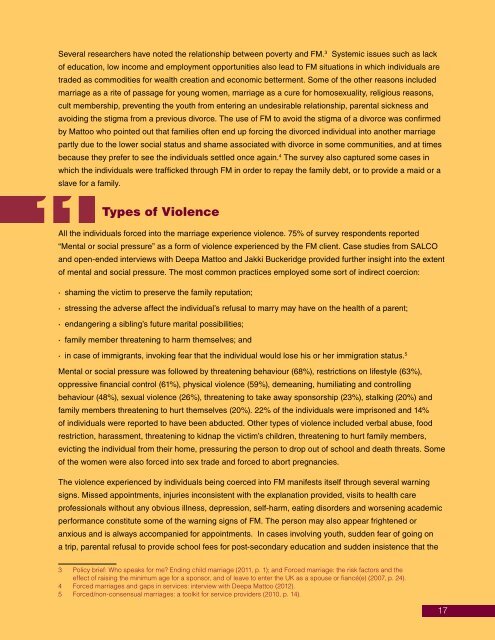SALCO - Who, If, When to Marry -The Incidence of Forced Marriage in Ontario (Sep 2013)
SALCO - Who, If, When to Marry -The Incidence of Forced Marriage in Ontario (Sep 2013)
SALCO - Who, If, When to Marry -The Incidence of Forced Marriage in Ontario (Sep 2013)
You also want an ePaper? Increase the reach of your titles
YUMPU automatically turns print PDFs into web optimized ePapers that Google loves.
Several researchers have noted the relationship between poverty and FM. 3 Systemic issues such as lack<strong>of</strong> education, low <strong>in</strong>come and employment opportunities also lead <strong>to</strong> FM situations <strong>in</strong> which <strong>in</strong>dividuals aretraded as commodities for wealth creation and economic betterment. Some <strong>of</strong> the other reasons <strong>in</strong>cludedmarriage as a rite <strong>of</strong> passage for young women, marriage as a cure for homosexuality, religious reasons,cult membership, prevent<strong>in</strong>g the youth from enter<strong>in</strong>g an undesirable relationship, parental sickness andavoid<strong>in</strong>g the stigma from a previous divorce. <strong>The</strong> use <strong>of</strong> FM <strong>to</strong> avoid the stigma <strong>of</strong> a divorce was confirmedby Mat<strong>to</strong>o who po<strong>in</strong>ted out that families <strong>of</strong>ten end up forc<strong>in</strong>g the divorced <strong>in</strong>dividual <strong>in</strong><strong>to</strong> another marriagepartly due <strong>to</strong> the lower social status and shame associated with divorce <strong>in</strong> some communities, and at timesbecause they prefer <strong>to</strong> see the <strong>in</strong>dividuals settled once aga<strong>in</strong>. 4 <strong>The</strong> survey also captured some cases <strong>in</strong>which the <strong>in</strong>dividuals were trafficked through FM <strong>in</strong> order <strong>to</strong> repay the family debt, or <strong>to</strong> provide a maid or aslave for a family.11Types <strong>of</strong> ViolenceAll the <strong>in</strong>dividuals forced <strong>in</strong><strong>to</strong> the marriage experience violence. 75% <strong>of</strong> survey respondents reported“Mental or social pressure” as a form <strong>of</strong> violence experienced by the FM client. Case studies from <strong>SALCO</strong>and open-ended <strong>in</strong>terviews with Deepa Mat<strong>to</strong>o and Jakki Buckeridge provided further <strong>in</strong>sight <strong>in</strong><strong>to</strong> the exten<strong>to</strong>f mental and social pressure. <strong>The</strong> most common practices employed some sort <strong>of</strong> <strong>in</strong>direct coercion:··sham<strong>in</strong>g the victim <strong>to</strong> preserve the family reputation;··stress<strong>in</strong>g the adverse affect the <strong>in</strong>dividual’s refusal <strong>to</strong> marry may have on the health <strong>of</strong> a parent;··endanger<strong>in</strong>g a sibl<strong>in</strong>g’s future marital possibilities;··family member threaten<strong>in</strong>g <strong>to</strong> harm themselves; and··<strong>in</strong> case <strong>of</strong> immigrants, <strong>in</strong>vok<strong>in</strong>g fear that the <strong>in</strong>dividual would lose his or her immigration status. 5Mental or social pressure was followed by threaten<strong>in</strong>g behaviour (68%), restrictions on lifestyle (63%),oppressive f<strong>in</strong>ancial control (61%), physical violence (59%), demean<strong>in</strong>g, humiliat<strong>in</strong>g and controll<strong>in</strong>gbehaviour (48%), sexual violence (26%), threaten<strong>in</strong>g <strong>to</strong> take away sponsorship (23%), stalk<strong>in</strong>g (20%) andfamily members threaten<strong>in</strong>g <strong>to</strong> hurt themselves (20%). 22% <strong>of</strong> the <strong>in</strong>dividuals were imprisoned and 14%<strong>of</strong> <strong>in</strong>dividuals were reported <strong>to</strong> have been abducted. Other types <strong>of</strong> violence <strong>in</strong>cluded verbal abuse, foodrestriction, harassment, threaten<strong>in</strong>g <strong>to</strong> kidnap the victim’s children, threaten<strong>in</strong>g <strong>to</strong> hurt family members,evict<strong>in</strong>g the <strong>in</strong>dividual from their home, pressur<strong>in</strong>g the person <strong>to</strong> drop out <strong>of</strong> school and death threats. Some<strong>of</strong> the women were also forced <strong>in</strong><strong>to</strong> sex trade and forced <strong>to</strong> abort pregnancies.<strong>The</strong> violence experienced by <strong>in</strong>dividuals be<strong>in</strong>g coerced <strong>in</strong><strong>to</strong> FM manifests itself through several warn<strong>in</strong>gsigns. Missed appo<strong>in</strong>tments, <strong>in</strong>juries <strong>in</strong>consistent with the explanation provided, visits <strong>to</strong> health carepr<strong>of</strong>essionals without any obvious illness, depression, self-harm, eat<strong>in</strong>g disorders and worsen<strong>in</strong>g academicperformance constitute some <strong>of</strong> the warn<strong>in</strong>g signs <strong>of</strong> FM. <strong>The</strong> person may also appear frightened oranxious and is always accompanied for appo<strong>in</strong>tments. In cases <strong>in</strong>volv<strong>in</strong>g youth, sudden fear <strong>of</strong> go<strong>in</strong>g ona trip, parental refusal <strong>to</strong> provide school fees for post-secondary education and sudden <strong>in</strong>sistence that the3 Policy brief: <strong>Who</strong> speaks for me? End<strong>in</strong>g child marriage (2011, p. 1); and <strong>Forced</strong> marriage: the risk fac<strong>to</strong>rs and theeffect <strong>of</strong> rais<strong>in</strong>g the m<strong>in</strong>imum age for a sponsor, and <strong>of</strong> leave <strong>to</strong> enter the UK as a spouse or fiancé(e) (2007, p. 24).4 <strong>Forced</strong> marriages and gaps <strong>in</strong> services: <strong>in</strong>terview with Deepa Mat<strong>to</strong>o (2012).5 <strong>Forced</strong>/non-consensual marriages: a <strong>to</strong>olkit for service providers (2010, p. 14).17


